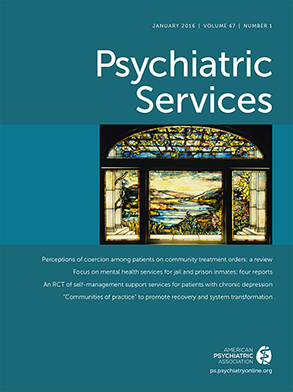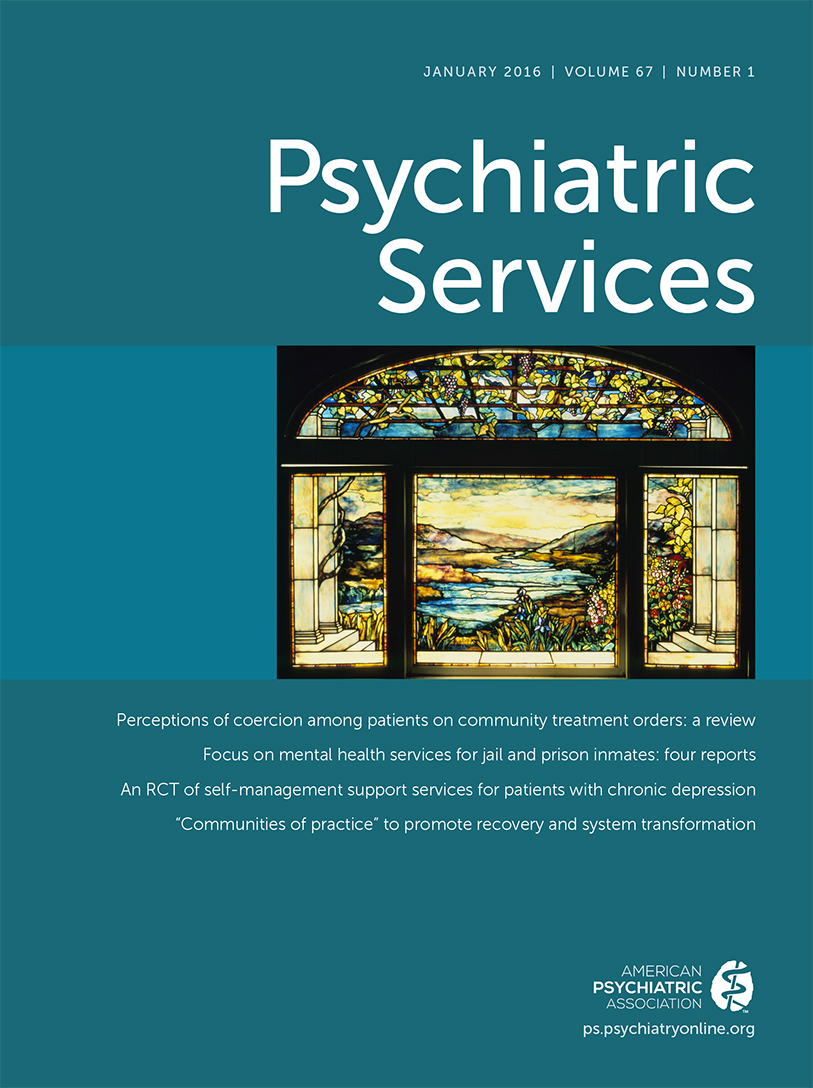Agitation is a common health problem that affects patients with psychiatric illnesses, such as schizophrenia and bipolar disorder, and neurodegenerative diseases, such as dementia. Historically, agitation has not been considered an illness in its own right but a set of psychiatric symptoms seen in several chronic diseases (
1). Although there is no consensus on a definition, agitation is referred to as a behavioral syndrome with nonpurposeful motor behavior, an increase in excitability, and deterioration of normal patient functions (
2). An episode of agitation varies from a few minutes to hours or even days (
3). An episode can signal the beginning of a behavioral emergency (
4,
5) and a complex dynamic situation that may lead to violence (
2) and that may present serious danger to the patient and others (
6). Little information on the epidemiology of agitation is available. Prevalence rates ranging from 4.3% (
7) to 10% (
1) in psychiatric emergency services have been reported, with a frequency of violent incidents between .4 and 33.2 annually per psychiatric patient with agitation (
8).
The economic burden of agitation has not been sufficiently studied. Research has focused on the burden of the underlying illness, especially in the case of schizophrenia (
9), bipolar disorder (
10), and dementia. However, agitation has a significant effect on society because it negatively affects the healing process, including direct care of the patient, adds to the caretaker's burden, and uses community resources.
The Red Española de Costes Hospitalarios (RECH) project was initiated to obtain a large database to provide reliable information on per-patient cost of hospital care. The network currently includes 14 general public hospitals in Spain. The hospitals have cost-accounting systems (full costing) in which cost distribution is based on activity-based criteria (ABC) (
11). The main objective of this study was to estimate hospital costs of agitation by analyzing basic minimum data from this hospital network.
Methods
The retrospective analysis used patient discharge data (including emergencies with hospital stays over 24 hours) from 14 hospitals. All hospital discharge records of patients admitted between 2009 and 2012 with a diagnosis of agitation (ICD-9-CM code 293.0) were selected, and the incremental cost was expressed in €2014. Costs for these patients and for a control group of patients with the same profile and complexity but without agitation were compared. Patients age 18 or younger, those with a hospital stay of less than 24 hours, and gynecology and obstetrics cases were not included in the sample.
The main variable was the cost of care of the hospitalized patient—that is, the economic value of the group of activities carried out for each patient during his or her stay (admission-discharge interval). This was determined by applying an ABC per-patient cost-accounting system that distributes hospital costs (full costing) for admitted patients and can be defined as the economic value of a patient's clinical care during hospitalization. All hospitals participating in the RECH project, including eight teaching hospitals, used this method for determining costs. The 14 hospitals were from six Autonomous Regions. The total number of patient stays between 2009 and 2012 at the hospitals was 925,750, with an average length of stay of 5.7 days.
Student’s t test was used as a hypothesis test, and a z test was used for the comparison of categorical variables; a two-tailed value of .05 was considered statistically significant. IBM-SPSS version 21.0 was used for statistical analysis.
Analysis of the incremental cost for patients with a diagnosis of agitation was set up in three stages: minimization of selection and time-selection biases, adjustment of a function of cost for patients in the selected sample, and an estimate for the incremental cost. Propensity score matching is often used to minimize biases, and patient samples were matched according to their propensity score profiles.
Econometric adjustment of the cost was established by using a generalized linear model for the logarithmic transformation of the cost per patient, including a dummy variable to identify patients with agitation, with propensity score as an adjustment variable. Other continuous variables used for adjustment were age, burden of comorbid conditions (with the weighted Elixhauser Index), and the relative weight of related groups using grouper 3M APR-DRG software (as a measurement of the complexity of the illness resulting in admission). Dummy variables were used to control categories such as sex, presence of an adverse event, emergency or planned admission, death during the hospital stay, and level of specialization of the hospital.
The incremental costs were quantified by using two different methods: comparison of the adjusted cost for patients with agitation and for those in the control group and estimation of the incremental costs according to the logic of recycled predictions, which estimated the cost for patients with agitation by using the hypothesis that all variables are equal for the control group, except for the diagnosis of agitation.
Results
A total of 355,496 hospital discharges met the inclusion criteria. Of these, 5,334 were of patients with a diagnosis of agitation. Among patients with a diagnosis of agitation, 47.2% were women and 78.0% had two or more comorbidities, compared with 45.2% and 60.1%, respectively, in the control group. The mean±SD age of patients with a diagnosis of agitation was 80.5±11.2, compared with 68.3±17.2 for the control group. Among those with agitation, 91.5% of admissions were related to an emergency, compared with 70.2% in the control group. Admissions were significantly longer among patients with a diagnosis of agitation: 12.0±11.5 days, compared with 9.0±10.1 days in the control group. [A table summarizing data on patient characteristics is available in an online data supplement to this report.]
The econometric model indicated that all adjustment variables were associated with higher costs for patients with agitation. As expected, the dummy variable of patients with a diagnosis of agitation also showed significantly higher associated costs. After econometric adjustment, a statistically significant difference of €472 (95% confidence interval [CI]=€351–€593) in estimated mean costs between the group with agitation and the control group was observed, with an increasing effect of 35% for the dummy variable of patients with agitation on costs. The distribution of the estimated cost by patient group and characteristics is presented in
Table 1. A recycled-predictions approach showed a difference in costs of €1,593 (CI=€1,556–€1,631) between patients with agitation and the control group. [The
online supplement presents further details of these analyses.]
Discussion and Conclusions
Our objective was to determine whether the presence of agitation entails an increase in the use of hospital resources and costs. We found a significant increase in hospital costs for patients with agitation compared with a control group without this condition. Findings indicate that agitation increased the use of hospital resources by at least 8%. For patients ages 18 to 54, considerable differences in costs were observed for patients with agitation. Among older patients, the differences in costs between the patients with and without agitation were smaller. Older patients typically have more complex conditions or complications, which may explain the smaller differences.
Although there are few previous studies to provide a context for our results, our findings appear to be in line with those of other studies of the cost of agitation. In a study analyzing routine medical reports of patients admitted to the Psychiatric University Hospital of Zurich, Warnke and colleagues (
12) determined that two syndromes—mania and hostility—were positively associated with length of hospital stay, accounting for about 5% of the variation of length. Peiró and colleagues (
13) conducted a retrospective review of 200 records of patients admitted to eight hospitals for acute psychosis in Spain from 1999 to 2001. Among these patients, 86% showed signs of aggressiveness and agitation during hospitalization. The study reported an average hospitalization cost of between €2,830 and €3,625 and an average stay of 21.78 days. In Spain, Martín Cazorla and colleagues (
14) reported a mean hospital stay in a mental health unit of 12.48±17.99 days for 31 patients with agitation.
The study was based on information recorded in the CMBD (Minimum Basic Dataset) of hospital discharges, which codes agitation according to the
ICD-9-CM (code 293.0), a code used for behavioral disorders compatible with psychomotor agitation. However, the lack of a specific diagnostic code can limit data reliability. This limitation and the retrospective design may have resulted in underreporting of psychomotor agitation in our study. Therefore, it is not possible to know how our estimates would be affected if all cases were reported. On the other hand, the RECH data set, although not fully statistically representative, comes from different types of acute care hospitals in different geographical areas of Spain and represents a robust instrument for health care–related, patient-level economic evaluations (
15). It is estimated that psychomotor agitation affects approximately 10% of patients (
9) in emergency cases and in acute areas of mental health services, far from the estimated 1.5% in our patient sample.
Although agitation is a relatively frequent condition among patients with chronic psychiatric or neurodegenerative illnesses, few studies of its epidemiology and economic burden are available because such information is not usually recorded as a final event in administrative databases, perhaps because agitation has traditionally been considered a secondary symptom and not an illness. Further research to quantify the economic burden of agitation, especially among patients whose agitation episodes result in violence or aggression, is necessary. Given the frequency of this condition, especially in mental health services, an early diagnosis along with rapid and safe therapeutic alternatives for high-risk patients should result in cost reductions and improve patient safety.
Acknowledgments
The authors acknowledge the support of the RECH group and Lisette Kaskens for her editorial support.

